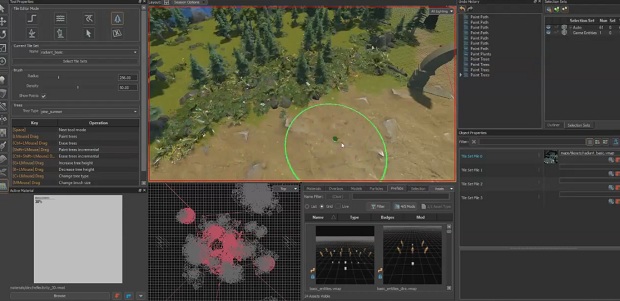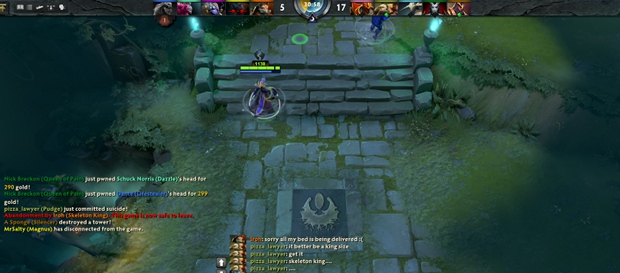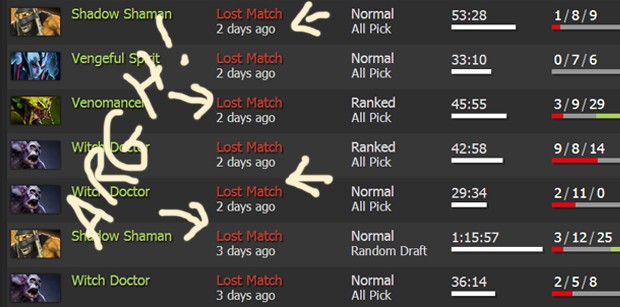
Three Lane Highway is Chris' column about Dota 2.
When someone describes something as a Gordian knot the presumption is that it's waiting for the sword. There's virtue associated with solving complicated problems quickly and decisively the legend of Alexander and the knot expresses a cultural preoccupation with the notion that twisted impossible things are deserving of a direct and just and violent 'solution', normally at the hands of somebody with unusual power and perspective (read: some dude with a sword.) Anything else, it follows, is a waste of time.
There are other ways of telling that story. In 333BC, a longstanding and much-revered Persian multiplayer puzzle game was hacked to pieces by a singleminded Macedonian powergamer who valued his experience above that of the other players. The game's (possibly real) forum must have been in uproar; I imagine they had something to say about it in the pages of Phrygian Hemp Gamer. This Alexander guy, they'd write, cared nothing for the intent of the game's designers or the rules that they'd created to ensure an optimal play environment. He didn't have the taste or patience to value complexity for its own sake, and his reductive actions had curtailed everybody else's freedom to enjoy it too. What a scrub. Broke game Midas fix.
Whether you agree with Alexander's imagined critics depends on whether you place greater value on the solved or unsolved version of the puzzle; whether the knot means more to you as a symbol of enduring quasi-divine complexity or as a demonstration of curt terrestrial pragmatism. This is one of those useful notional binaries that worms its way through civilisation linking myriad historic acts of virtue and evil and art, from military interventionism to Romantic poetry to "truthiness" to Lovecraft to the guy in every comments thread on every article on the internet who begins by typing "well, actually..."
In this case I'm bringing it up because it helps to explain why you can't forfeit matches in Dota 2 and why that is broadly a good thing. This week's column is a response to Arthur Gies' argument in favour of a 'white flag' option on Polygon, in which he kindly cites my own writeup of the TI4 Grand Final. I don't entirely agree with Arthur but I can see where he's coming from, and I hope the fact that I've spent the first three paragraphs of this column framing him as the Alexander the Great of free time helps him to forgive me for taking the other side, at least to the extent that I'm going to.
A given game of Dota 2 is a Gordian knot awaiting solution by one team or the other. By withholding the 'forfeit' button, Valve withhold the sword. The only way you are going to untie this knot is by picking at it with your fingers while nine other people attempt to do the same some helping your effort, others hindering it. This principle is the source of the game's enduring complexity and its capacity to continually create new stories over time.
The life and value and charm of Dota is bound up in the notion that it is this absurd and vastly complex system of rules that players encounter socially. In order to bring out the best results from that system the last-minute upsets, the extraordinary moments of collective skill an underlying structure is needed to ensure that all of the game's variables have the opportunity to resolve themselves appropriately. That means keeping people in the game. It begins within a couple of from-on-high commandments ('Thou Shalt Not Abandon') and extends to social conventions like condemning people who rage or deliberately feed or sulk in the fountain.
Your ability to forfeit the game or not, as is the case here is part of an unwritten contract between yourself, your teammates, your opponent and the game's developer. Giving up under the wrong conditions constitutes a breach of that contract on multiple fronts: you deprive your allies of the right to try, your opponents of their right to win, and the developer of their right to provide you with an appealing alternative to not playing their game at all. The game asks you to grant it a certain amount of your time a commitment extended, as Arthur rightly points out, by the punishments levied at people who bail early on the basis that it will always be more interesting to stay than it is to leave. The implication is that the systemic potential of the game is fundamentally devalued the moment an individual or a team gains the ability to hit the 'nope' button.
In return for your commitment to a given match, the developer promises to provide a game system that continues to generate new possibilities over the course of its lifespan. In the aftermath of the International, that's not the case for Dota 2: the laning phase determines too much of what follows, comeback mechanics aren't effective enough, and the midgame is becoming an interstitial phase before a foregone conclusion rather than the second stage in an evolving debate. Before version 6.82 arrives to throw the system back into welcome disarray, pro-surrender arguments like Arthur's are given weight by the fact that the game itself is falling short of fulfilling its part of that four-way contract. You're being asked to commit your time to play but not being provided with a sufficiently diverse system to play with. As the sword is withheld, the knot tightens and atrophies. You're owed a better experience.
It's understandable to ask for your sword back in this scenario, but incorrect because the problem is within the game, and you can't fix a systemic problem by shutting the system down.
The current structure is appropriate at the level of players like Arthur and I, people who play Dota under substantially variable social conditions. Maybe we're solo, maybe we're with a few friends, maybe we're in a full party; maybe our opponents are solo, maybe they're a stack, and so on. Maybe they're assholes. Maybe we're assholes. When the composition and disposition of a game's participants are this diverse you can't leave the point at which the game ends up to group debate. Democracy doesn't work that well. Dota 2 has a problem with players who mentally or physically abandon the game as it is. Playing until the ancient explodes is the only way to manage that degree of chaos.
It's different in pro games, where the composition of each team is a known quantity and the social environment in which the game takes place carries with it an assumed level of participation. Professional players are obligated to play, so they can be trusted with the power to end the game early when appropriate. A competitive context grants the 'GG' call tremendous significance it becomes a feature rather than an external imposition, and in many cases ending a game early is a key part of ensuring a team gets off to a good start in the next one. It's about creating the best environment for continued play, rather than simply cutting the experience short to avoid discomfort.
There's an argument to be made for extending these powers further down the chain to the point where they're available to other types of player. They used to be before team matchmaking was changed, formally registered teams of five could queue for matches against one another and the surrender power was available. I miss the feature. It has become far harder for my fledgling team to practice efficiently since team matchmaking was merged with ranked. Games take too long; where before we could get two or three done in an hour we now get one. This is partly due to the metagame and partly due to changes to the matchmaking system, and it's a problem that we've had to look outside of the game client to solve. Where before we had a functioning way to practice in-game, now we're looking to scrim groups and in-house leagues.
It was very unusual to see teams abuse the forfeit option in team matchmaking because, like pro players (and this is probably the only point of commonality at the level I play) everybody involved had agreed to be there. They'd made a prior commitment to the game and their teammates. Valve should consider this: the social conditions that make surrendering viable extend beyond the competitive scene and private lobbies. Really, any time two full parties clash it can be assumed that there are lines of communication and understanding in place to offset the potential downsides of allowing players to wave the white flag. It's a more stable environment by default, and therefore Dota's vulnerable systems need less protection from rogue elements.
I'd like Valve to reintroduce the 'GG' option to team ranked matchmaking and perhaps five on five matchmaking as a whole because it's a change that encourages people to play more Dota, not less. Better Dota, too: this is a game designed to be played by a full team, and finding a full team would become the best way to ensure that you can't be fountain-farmed at the conclusion of a losing match. The solution to Arthur's problem would be to turn his three-stack into a five-stack. A well-implemented surrender power restricted to certain parts of the game could encourage greater socialisation between players and more exciting games as a result: an act of pruning, rather than cutting.
There's a 'swords to plowshares' analogy to be made here, but let's not.
To read more Three Lane Highway, click here.













![[I'll try to think of witty captions for Pip's pictures -ed]](https://www.rockpapershotgun.com/images/14/jul/n00b1.jpg)
